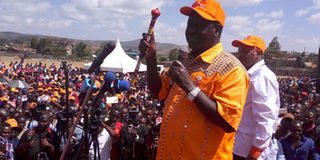Leadership now and after elections

ODM leader Raila Odinga addressing Samburu residents at Kenyatta Stadium in Maralal town on February 2, 2017. Mr Odinga should tell us what he brings to the table. PHOTO | GODFREY OUNDOH | NATION MEDIA GROUP
What you need to know:
- By helping to educate citizens, irrespective of their tribe or political affiliation, the two did what international development institutions now do as a matter of course.
- If Kibra were to be used as the microcosm of his leadership and developmental capacities, one would be tempted to ask what he hopes to achieve at the national level.
The stakes are high and leadership is a common word in uncommon situations these days.
What will it take for the motley contenders in the August 8 General Election to make successful bids for public office?
It is also an open season for giving and receiving “favours” in a lopsided kind of way, with the givers likely to be the ones scouring the country for votes and the recipients spoilt for choice, as attention shifts to their power to decide whom to award a raft of jobs to.
The list is impressive enough and all these slots must be filled: president, deputy president, governor, senator, woman representative, member of Parliament and member of county assembly.
It is election campaign time and the scorecards are in the voters’ hands.
Mr Raila Amolo Odinga, the ODM leader, is eyeing the No. 1 post of President of the Republic of Kenya.
Does he have what it takes? This brings to mind a sobering observation from the global leadership guru and author of the best-selling The Monk Who Sold His Ferrari series, Robin Sharma: “You cannot lead others until you have first learned to lead yourself.”
Kenya takes pride in its share of selfless individuals, who have impacted positively on the lives of its citizens long after their demise.
Thomas Joseph Mboya and Dr Julius Gikonyo Kiano were two such men.
In the late 1950s to the early 1960s, Mboya, together with Kiano launched the academic airlifts of Kenyans to the United States, whose impact is still being felt across the globe.
By organising the airlifts and scholarships for young men and women to study in America, the two politicians built a strong foundation of leadership for a young nation shaking off the shackles of colonialism.
TRANSFORMING LIVES
Around that time, Barack Obama Senior also flew to the US to study and ended up not only with a fine education from Harvard University, but also sired a man who would later become the first African American President of the US, serving for two terms from 2008 to 2016, Barack Hussein Obama.
The airlifts birthed Kenyan scientists, medical doctors and surgeons, environmentalists, engineers, administrators — a valuable human resource that has over the years helped to shape and steer the Kenya we know to date.
By helping to educate citizens, irrespective of their tribe or political affiliation, the two did what international development institutions now do as a matter of course.
Today’s leadership is not necessarily about the people “in charge”, but about something bigger in which everyone participates.
What can we learn from Mr Odinga? Without doubt he is one of the most charismatic Kenyan politicians today.
That he commands a fanatical following and his influence across generations, ethnicities and political affiliations is not in question.
No wonder his followers refer to him fondly as “Jakom”; “Tinga”; “Agwambo” and “Baba”.
How will this colossus transform the lives of fellow Kenyans?
Those who criticise his development record argue that he has squandered too many opportunities to use his massive influence to ensure that his followers grow wealth and sustain livelihoods beyond the basic needs such as clean water, food, shelter, health and education.
A case in point is Kibra, a large support base in Lang’ata constituency, Nairobi, where Mr Odinga held sway as the member of Parliament for nearly two decades.
Most of Kibra’s residents still live in extreme poverty in the vast and unplanned settlement.
ODINGA'S VISION
They earn less than $1 a day and unemployment rates are high and at best, life is tough.
If Kibra were to be used as the microcosm of his leadership and developmental capacities, one would be tempted to ask what he hopes to achieve at the national level.
How does he intend to galvanise the support and resources to turn around Kenya’s development agenda and expedite the achievement of Vision 2030?
Or, as some of his critics have put it, is he likely to forget that he is the president and join demonstrators and anti-government lynch mobs?
Would he accept positive criticism or would his critics have to live in mortal fear of his supporters?
Either way, when it comes to social and economic development, or the mentorship of younger leaders, Mr Odinga must prove his critics wrong by turning himself inside-out to show that he has only good intentions for Kenya.
Some would argue that he needs to show his good side and move beyond the current grandstanding to tell the people of Kenya what he envisions for this country.
Let him tell us what he brings to the table.
Mr Wambilianga is a political commentator. [email protected]





